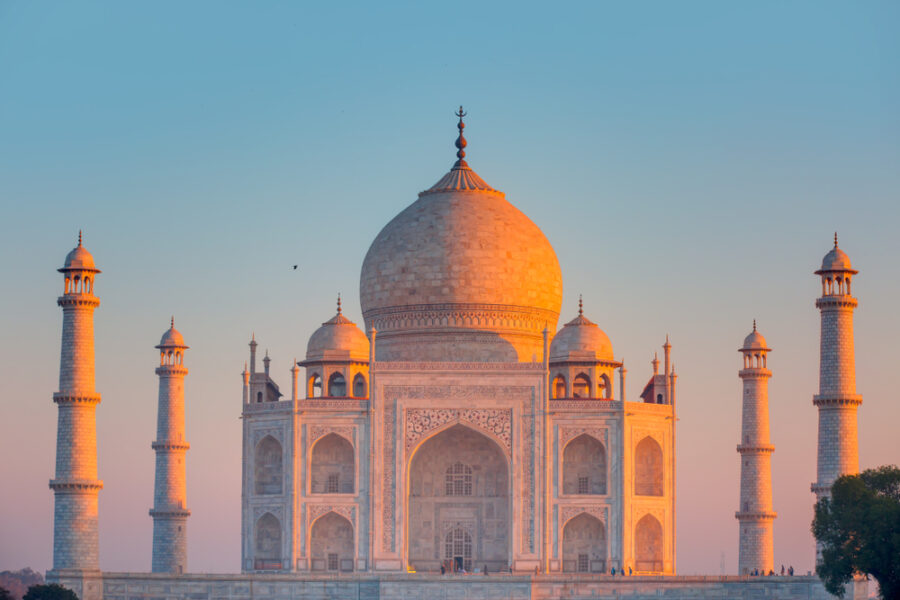Embark on an enchanting voyage to the Taj Mahal, India’s unparalleled monument to love, and immerse yourself in the timeless beauty of this majestic architectural masterpiece. Nestled along the banks of the Yamuna River in Agra, this breathtaking wonder of the world beckons travelers from all corners of the globe to witness its awe-inspiring splendor and delve into the captivating tale of eternal love that inspired its creation. A journey to the Taj Mahal is more than just a trip to a historical landmark; it’s an invitation to awaken your senses and rekindle your passion for exploration. In this comprehensive guide, we’ll unveil the secrets of the Taj Mahal and help you make the most of your visit to this iconic symbol of India’s rich cultural heritage.

Historical Background
The Taj Mahal, a UNESCO World Heritage site, is a testament to the grandeur and opulence of the Mughal Empire. Commissioned in 1632 by Emperor Shah Jahan as a mausoleum for his beloved wife Mumtaz Mahal, this exquisite monument took over two decades and the labor of 20,000 skilled artisans to complete. Constructed from pristine white marble and adorned with intricate inlay work and precious gemstones, the Taj Mahal epitomizes the pinnacle of Mughal architecture and craftsmanship.
Today, the Taj Mahal continues to captivate the hearts and minds of millions, as they marvel at its ethereal beauty and ponder the depth of devotion that inspired its creation.

Best Time to Visit the Taj Mahal
To fully appreciate the magnificence of the Taj Mahal, timing is essential. The most favorable months to visit are between November and February, when the weather in northern India is cool and pleasant, providing optimal conditions for exploring the monument and its surroundings. However, be aware that December and January can be quite foggy, which may obscure the Taj Mahal’s beauty.
During the scorching summer months of April to June, temperatures in Agra can soar above 40°C (104°F), making sightseeing uncomfortable. The monsoon season from July to September brings heavy rains and high humidity, which can also hinder your experience.
Costs and Admission
A visit to the Taj Mahal can be tailored to suit various budgets and preferences. General entrance tickets for foreign tourists cost ₹1,100 (approximately $15) and include shoe covers, a water bottle, and a tourist map of Agra. Indian citizens and visitors from SAARC and BIMSTEC countries pay a reduced fee of ₹50-₹550 (approximately $0.65-$7.50).
For a seamless experience, consider booking a guided tour, which typically includes transportation, entrance fees, and the expertise of a knowledgeable guide. Prices for guided tours vary depending on the provider and the inclusions, but expect to pay between $30-$100 for a standard half-day or full-day tour.
Savvy Advice for Your Taj Mahal Visit
- Arrive early: The Taj Mahal is open from sunrise to sunset, with the exception of Fridays. To avoid the crowds and capture stunning photos, plan to arrive at the monument just before sunrise.
- Dress modestly and comfortably: As the Taj Mahal is a mausoleum and a place of cultural significance, dressing modestly is advised. Wear comfortable walking shoes and bring a hat and sunscreen
- to protect yourself from the sun. In the cooler months, dress in layers to accommodate temperature fluctuations.
- Prepare for security checks: Security at the Taj Mahal is strict, and several items, such as large bags, food, and tripods, are prohibited. Check the official guidelines beforehand to ensure a hassle-free visit.
- Be mindful of photography restrictions: While photography is allowed in the outer areas of the Taj Mahal, it is strictly prohibited inside the main mausoleum. Remember to respect these guidelines to help preserve the sanctity of the site.
- Hire a knowledgeable guide: A guided tour can greatly enhance your understanding of the Taj Mahal’s history, architecture, and cultural significance. Local guides can be hired at the entrance or pre-booked through tour operators.
- Visit during a full moon: For a truly magical experience, consider visiting the Taj Mahal during a full moon night. The monument is open for night viewing on full moon nights and two days before and after, allowing visitors to witness the ethereal beauty of the Taj Mahal bathed in moonlight
Beyond the Taj Mahal
While the Taj Mahal is undoubtedly the highlight of any visit to Agra, this historic city has much more to offer. Explore other fascinating Mughal-era landmarks, such as the Agra Fort, Fatehpur Sikri, and Itimad-ud-Daulah, also known as the “Baby Taj.” Delve into the vibrant local culture by visiting bustling markets, sampling delicious street food, and witnessing the centuries-old art of Pietra Dura, the intricate inlay work that adorns the Taj Mahal.
Furthermore, consider extending your journey to experience the other gems of India’s famous Golden Triangle, which includes the bustling capital city of Delhi and the “Pink City” of Jaipur, known for its stunning palaces and forts.
In conclusion, a visit to the Taj Mahal is a transformative experience that will leave you with cherished memories and a newfound appreciation for the enduring power of love. As you stand before this architectural marvel, take a moment to reflect on the passion, devotion, and artistic genius that brought it to life. And as you venture forth, let the captivating beauty of the Taj Mahal inspire you to explore new horizons, embrace the unknown, and continue your journey of self-discovery.
Embark on an unforgettable adventure and experience the timeless allure of the Taj Mahal for yourself. The world is vast, and your next awe-inspiring journey awaits. Let India’s iconic symbol of eternal love be the catalyst that rekindles your wanderlust and sets your soul alight with the thrill of exploration.









